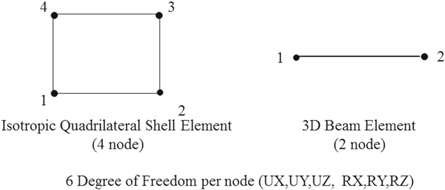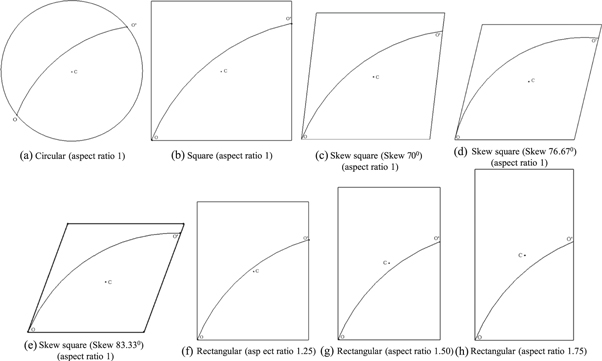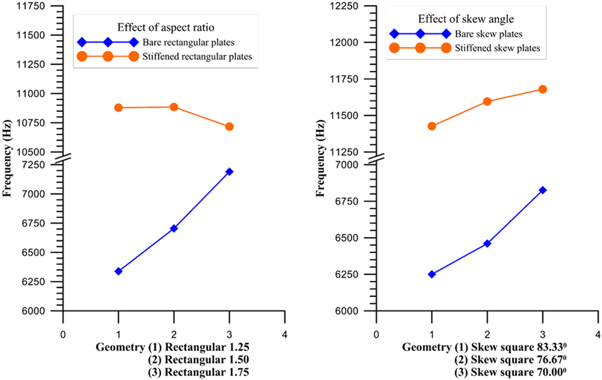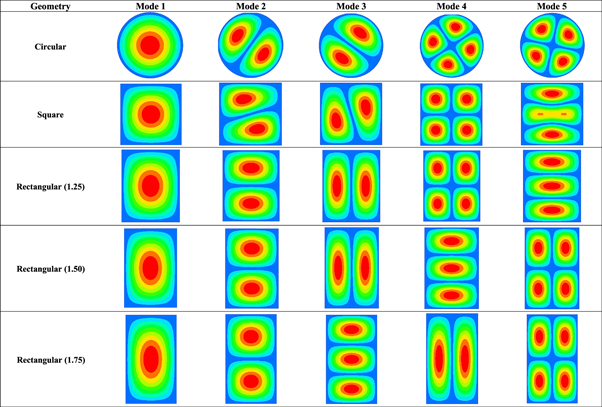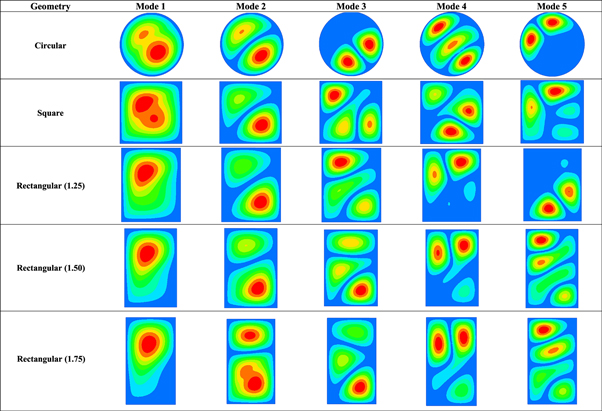Abstract
Light weight thin alloys and composite materials have revolutionized aerospace, marine, electronics and construction industries. Based on their application and structural behaviour, plates are often designed in arbitrary shapes. This paper deals with free vibration analysis of simply supported plates with different geometries. The plates are modelled with a stiffener which is curvilinear in shape. To enable comparison of plates, three parameters viz., the area of plates, starting point of the stiffener and curvature of the stiffener were kept constant. The Finite Element model was developed for free vibration analysis using FEAST (Finite Element Analysis of Strctures). The geometries considered were circular, square, rectangular (with aspect ratio of 1.25, 1.50 and 1.75, respectively) and skew square (with 70o, 76.67o and 83.33o skew angles, respectively). It was observed that the stiffness increased with the increase in aspect ratio of bare plates unlike the case of stiffened plates. In the case of stiffened plates, the stiffness increased with increase in aspect ratio up to 1.50 and thereafter decreased for the aspect ratio of 1.75. The bare and stiffened plates showed an increase in stiffness with increase in skewness of the geometry. Among the geometries considered, the stiffener was found to be most effective for the circular plate (110% increase in stiffness compared to bare plate) and least effective for the rectangular plate (50% increase in stiffness compared to bare plate) with 1.75 aspect ratio. The rectangular plate with aspect ratio 1.75 had the maximum overall stiffness and the circular plate had the minimum overall stiffness in the case of bare plates. In the case of stiffened plates, skew plates with 70o skew angle had the maximum overall stiffness and the circular plate had the minimum overall stiffness.
Export citation and abstract BibTeX RIS
1. Introduction
Plates are used for many structural applications such as aerospace (aircrafts, rockets, missiles etc), civil (multi-storied buildings, bridges etc), electronics (thin-walled sheets, tubes, films etc) and marine industries (ships, submarines etc). To enhance the stiffness and stability of a structural system, stiffened plates are used in many engineering applications with the added advantage of being light weight [1]. The criteria of aerodynamics and strength often leads to conflicting challenges as the former leads to thinner cross sections to minimize the drag force and maximize the lift force, while the latter necessitates larger cross sections to resist loads without failure. Stiffeners in plates add value to the structure as it does not alter the aerodynamic shape of the exterior surface but increases the stiffness of the overall structure without significantly increasing its weight [2]. Xue et al [1] carried out free vibration analysis of a flat stiffened plate with an initial crack, and the corresponding mode shape behaviour was studied using Ritz method and finite element simulation. It was observed that stiffness and frequency are dependent on crack propagation and position of the stiffener and with the increase in the crack length, the magnitude of these stiffness and frequency decreased. Tamijani et al [3] carried out free vibration analysis of curvilinear stiffened plates by using a laser vibrometer and compared the experimental values with the analytical results and found good agreement between both.
Zhao et al [4] used the finite element approach to study the prestressed vibration modes of a curvilinearly stiffened composite panel which was subjected to multiple in-plane loads. The study concluded that with the increase in stiffener-depth ratio, the buckling load capacity and frequency of the plate increased. Wang et al [5] made a comparison between the performance of structures with varying configuration of stiffeners and it was observed that structural efficiency was greatest with curved stiffeners. Doan et al [6] presented a simulation model for free vibration and buckling analysis of cracked Mindlin plates using phase-field method. A rectangular plate clamped at two opposite edges and subjected to uniform load was studied. It was observed that the crack length decreased with increase in thickness of the plate, and consequently resulting in an increased frequency. Rajwat et al [7] carried out free vibration analysis of stiffened laminated rectangular plates using finite element method. It was observed that frequencies of the plate increase with increase in plate eccentricity.
Based on free vibration analysis of stiffened laminated plates [8], a mathematical model for stiffened square plate is developed. Different numerical and analytical methodologies have been used for studying the behaviour of plates (bare and stiffened) under various loading conditions [9–18]. Recent studies suggest that curvilinear stiffeners are more effective in stiffening the overall plate as compared to the straight stiffeners [19–23]. However, the authors haven't come across any literatures dealing with the comparative study of different plates geometries with curvilinear stiffener. As a fulfilment of this existing gap in research, different geometrical shapes (circular, square, skew and rectangular) are considered in this study. The dimensions are varied for rectangular and skew geometries by varying the aspect ratio (length/breadth ratio) and skew angle, respectively. Finite Element Analysis (FEA) is carried out using FEAST and the obtained results are compared.
2. Methodology
Free vibration analysis was performed using FEAST (Finite Element Analysis of Structures) software developed by the Indian Space Research Organisation (ISRO)/Vikram Sarabhai Space Centre (VSSC). Validation of the analysis tool is carried out by comparing with results available in literature for existing plate geometries with curvilinear stiffener. Plates are modelled in FEAST and suitably meshed. Four noded isotropic quadrilateral shell element and two noded beam element is used to model plate and stiffener respectively (figure 1). All mesh elements are verified for aspect ratio and skew angle to maintain consistency in meshing. For stiffened plates, manual meshing (by selecting nodes) was necessary to deal with the complexity at the stiffener and plate junction. The model was re-run multiple times with smaller elements in subsequent runs to obtain the necessary results required to perform convergence study of the Finite Element Model. The mass of plate considered as lumped and the mode of extraction is based on the number of modes. A Total of five modes were considered in the present study. Lanczos Eigen solver, the iterative algorithm devised by Cornelius Lanczos is used in the present simulation. Equation (1) is used to solve eigen value problems.

Where, [K ] is the stiffness matrix,  is natural frequency in radians per second, [M] is mass matrix and {D} is nodal displacement amplitude vector. The generalized eigen problem for free vibration analysis is shown by equation (2).
is natural frequency in radians per second, [M] is mass matrix and {D} is nodal displacement amplitude vector. The generalized eigen problem for free vibration analysis is shown by equation (2).

Where x represents the vibration mode shapes, or eigen vectors and the  's are the vibration frequencies or eigen values. In vibration problems, to converging eigen values, a shift σ is introduced and then problem is inverted (refer to equation (3)).
's are the vibration frequencies or eigen values. In vibration problems, to converging eigen values, a shift σ is introduced and then problem is inverted (refer to equation (3)).

Where,  represent the eigen value. Substituting equation (3) in equation (2) and solving we get the following equation.
represent the eigen value. Substituting equation (3) in equation (2) and solving we get the following equation.

Figure 1. Elements used for meshing.
Download figure:
Standard image High-resolution imageEquation (4) is in the form of  (standard eigen value equation). Lanczos algorithm is used to compute the eigen values from equation (4).
(standard eigen value equation). Lanczos algorithm is used to compute the eigen values from equation (4).
2.1. Modelling approach
A total of eight geometrical shapes (figure 2) were considered in the present study. For a meaningful comparison of these shapes, the plate area is kept constant along with the origin and shape of the stiffener for all plate geometries. The considered geometries are (a circular plate, a square plate, a rectangular plate with three (1.25, 1.50, 1.75) aspect ratios (length/breadth ratio) and a skew square plate with three (70o, 76.67o, 83.33o) skew angles) analysed to obtain the behaviour of plates with and without the curvilinear stiffener. The geometric position of the stiffener is calculated using a MATLAB code such that it will start at the left bottom corner of the plate (except circular) and end at the opposite edge of the plate (figure 2).
Figure 2. Considered geometries for finite element simulation.
Download figure:
Standard image High-resolution imageIn this study, the natural frequency and corresponding time periods are obtained from the simulations for different modes from the vibration analysis.
2.2. Model validation
Tamijani and Kapania [24] studied free vibration analysis for a rectangular plate with a single curved stiffener (figure 3) by using the mesh free method and ANSYS. Qin et al [25] studied the same plate geometry for free vibration analysis. The same plate was considered in our study and modelled in FEAST to verify the accuracy of analysis tool. The geometric and material properties were: Young's modulus (E) = 73 GPa, mass density (ρ) = 2837 kg m−3, Poisson's ratio (μ) = 0.33, width of plate (a) = 606.9 mm, length of plate (b) = 711.2 mm, Thickness of plate (t) = 6.25 mm, height of stiffener (hs) = 22.4 mm and width of stiffener (bs) = 4.06 mm.
Figure 3. Curvilinearly stiffened rectangular plate (with a single stiffener).
Download figure:
Standard image High-resolution imageThe natural frequencies corresponding to first five modes are investigated and compared with existing results table 1. The results agree with a maximum error of 3.5% amongst the various methods (refer table 1) used for the model validation.
Table 1. Comparison of Frequency (Hz) obtained using different analysis.
| Mode | Present study | Qin et al [25] | Meshfree [24] | ANSYS [24] | NASTRAN [25] |
|---|---|---|---|---|---|
| 1 | 83 | 86 | 83 | 84 | 82 |
| 2 | 182 | 185 | 175 | 183 | 179 |
| 3 | 214 | 215 | 217 | 213 | 210 |
| 4 | 321 | 316 | 319 | 316 | 310 |
| 5 | 347 | 351 | 327 | 347 | 339 |
Tamijani et al [3] performed free vibration experiments for a plate with two curvilinear stiffeners (figure 4). The same stiffened plate was modelled and analysed for additional validation of our model. The material properties are given as Young's modulus (E) = 73.08 GPa, Poisson's ratio (μ) = 0.33, mass density (ρ) = 2851 kg m−3 and thickness of plate (t) = 6.25 mm. The comparison table 2 of frequencies (Hz) for the first five modes indicated close agreement of FEAST results with Meshfree and Ritz method.
Figure 4. Curvilinearly stiffened rectangular plate (with two stiffeners).
Download figure:
Standard image High-resolution image2.3. Problem description
As stated above, one of the methods adopted for comparison of different geometrical shapes is by maintaining equal area for all plates. The origin of each geometry was considered at point O (figure 2). To maintain the constant curvature of the stiffener (with length automatically fixed such that it meets the other edge), equation (5) is used to calculate the end coordinates of the stiffener (figure 2). OO' is the starting and end point of the curvilinear stiffener and C is the centre of respective geometry. The geometrical and material properties considered table 3 were adopted [26, 27] from the literature.
Table 3. Dimensional properties of considered plates.
| Geometry | Dimension | |||
|---|---|---|---|---|
| Diameter (mm) | Length (mm) | Width (mm) | Aspect Ratio/Skew angle | |
| Circular | 15.84 | — | — | 1/-- |
| Square | — | 14.04 | 14.04 | 1/-- |
| Rectangular 1.25 | — | 12.56 | 15.70 | 1.25/-- |
| Rectangular 1.50 | — | 11.46 | 17.19 | 1.50/-- |
| Rectangular 1.75 | — | 10.61 | 18.57 | 1.75/-- |
| Skew square 70.00o | — | 14.04 | 14.04 | 1/70o |
| Skew square 76.67o | — | 14.04 | 14.04 | 1/76.67o |
| Skew square 83.33o | — | 14.04 | 14.04 | 1/83.33o |
Table 4 lists the required properties of plate and stiffener for finite element simulation. For free vibration analysis, mass density (ρ) is taken as 4.506 g cm−3. In the present work, rectangular geometry was analysed for every 0.25 increase in aspect ratio up to 1.75 (limit beyond which curvilinear stiffener won't be effective). For the skew square geometries considered in this study, as the initial slope of the curvilinear stiffener is already subtending an angle of 70o with the horizontal; only skew angles equal to or greater than 70o was practically possible (so that the stiffener is contained fully within the plate boundaries) and hence considered.

Table 4. Properties of a plate and stiffener.
| Plate | |
| Support condition | Simply supported |
| Area | 197.05 mm2 |
| Young's Modulus | 1.1721 × 105 N mm−2 |
| Thickness of plate | 0.254 mm |
| Stiffener | |
| Dimension | 2.54 mm x 0.254 mm |
| Young's Modulus | 1.1721 × 105 N mm−2 |
3. Results and discussion
Free vibration analysis is carried out for bare and stiffened plates for geometries namely circular, square, rectangular with three aspect ratios and skew square with three skew angles. Simply supported boundary condition is adopted for all the models. Vibration modes, natural frequencies and corresponding time periods were studied and compared.
The mass participation in mode 1 was ~70%–80%. Therefore, the comparison is made for mode 1 frequencies and time periods for all geometries considered in this study. The results obtained through the study affirmed the positive correlation between frequency and stiffness (natural frequency is directly proportional to square root of stiffness). From figure 4, it is observed that frequency is maximum (7190.15 Hz) for a rectangular plate with aspect ratio 1.75 in bare condition whereas it is maximum (11679.40 Hz) in a skew plate with 70o angle under stiffened condition. Among the models analysed, frequency values were the least for circular plate for bare and stiffened conditions with values of 4934.48 Hz and 10328.60 Hz respectively. Figure 5 shows the frequency comparison of all plates.
Figure 5. Frequency comparison of plates for mode 1.
Download figure:
Standard image High-resolution imageTable 5 shows the percentage increase in frequency after introducing stiffener to the plates. It is observed that the maximum frequency increased by 52.23% for circular plate and minimum frequency increased by 32.91% for rectangular plate with aspect ratio 1.75. Figure 6 shows the comparison of time period of vibration of all plates which has an inverse relationship with frequency (equation (3)). Time period is maximum for bare and stiffened circular plates with magnitudes of 20.26 × 105 s and 9.68 × 105 s, respectively. Minimum time period was observed for skew plate with 70o angle for bare and stiffened conditions with magnitudes of 14.65 × 105 s and 8.56 × 105 s, respectively.

Where,  is natural frequency and T is time period of the respective mode.
is natural frequency and T is time period of the respective mode.
Table 5. Percentage increase in natural frequency of stiffened plates compared to bare plates.
| Plate geometry | Percentage increase (%) |
|---|---|
| Circular | 52.23 |
| Square | 41.54 |
| Rectangular 1.25 | 41.74 |
| Rectangular 1.50 | 38.40 |
| Rectangular 1.75 | 32.91 |
| Skew 70o | 41.56 |
| Skew 76.67o | 44.29 |
| Skew 83.33o | 45.30 |
Figure 6. Time period comparison of plates for mode 1.
Download figure:
Standard image High-resolution imageFrom table 6, it is observed that time period reduction was maximum for a stiffened circular plate (109.31%) and minimum for stiffened rectangular plate with aspect ratio 1.75 (59.83%) compared to respective bare plate cases.
Table 6. Percentage decrease in time of stiffened plates compared to bare plates.
| Plate geometry | Percentage decrease (%) |
|---|---|
| Circular | 109.31 |
| Square | 71.06 |
| Rectangular 1.25 | 71.64 |
| Rectangular 1.50 | 62.33 |
| Rectangular 1.75 | 59.83 |
| Skew 70o | 71.10 |
| Skew 76.67o | 79.49 |
| Skew 83.33o | 82.82 |
As the area of each plate has been maintained constant in the anaysis, the variation of natural frequency provided deeper insights into the dynamic properties of each. Amongst the geometries considered, circular bare plate had the least frequency. In addition, in the case of the circular plate, the modes 2 and 3 and modes 4 and 5 showed the same frequency, respectively due to the equivalence observed in the corresponding mode shapes attributed to the bi-directional symmetrical nature of circular plate.
Using equation 7, the percentage increase in mass of stiffened plate compared to bare plate is calculated. The percentage increase in mass is only ~15% compared to the much higher increase in strength and stiffness of the plate.

The variation of dynamic properties of bare rectangular plates with changing aspect ratio is studied. From table 7 and figure 7, it is observed that the frequency increased with the increase in aspect ratio (for square plate aspect ratio is 1) for bare plate geometries. This is attributed to the reduction in breadth of the plate with increase in aspect ratio consequently resulting in the plate edges along the length to move closer to the center thereby increasing the overall stiffness. However, in case of stiffened plates, this behavior is different (figure 8(a)) due to the combined effect of aspect ratio, stiffener position and geometry. In case of the stiffened plates, with increase in aspect ratio, the frequency increased up to the aspect ratio 1.50 and decreased thereafter.
Table 7. Bare plate frequencies (Hz) for first five modes.
| Mode | Circular | Square | Rect. 1.25 | Rect. 1.50 | Rect. 1.75 | Skew Square 70o | Skew Square 76.67o | Skew Square 83.33o |
|---|---|---|---|---|---|---|---|---|
| 1 | 4934 | 6183 | 6338 | 6705 | 7190 | 6826 | 6460 | 6250 |
| 2 | 13792 | 15468 | 13745 | 12860 | 12447 | 15374 | 15083 | 15118 |
| 3 | 13796 | 15468 | 17957 | 20655 | 21253 | 18783 | 17228 | 16153 |
| 4 | 25291 | 24577 | 25196 | 23147 | 23464 | 24911 | 24612 | 24559 |
| 5 | 25313 | 30907 | 26094 | 26651 | 28573 | 33940 | 32221 | 31222 |
Figure 7. Comparison of bare plate frequencies (Hz) for the first five modes of all geometries.
Download figure:
Standard image High-resolution imageFigure 8. Effect of (a) aspect ratio and (b) skewness on frequency for bare and stiffened.
Download figure:
Standard image High-resolution imageFrequency and stiffness also changed with increase in skewness of bare and siffened plates (refer table 8). With increase in skewness, stiffness and frequency in different modes increased (considering square plate with 90o angle) for both bare and stiffened plates. Due to the increase in skewness, the boundaries of the plate move towards the center C of plate and subsequently increases the overall stiffness for both bare and stiffened plates (figure 8(b) and 9).
Table 8. Stiffened frequencies (Hz) for the first five modes.
| Mode | Circular | Square | Rect. 1.25 | Rect. 1.50 | Rect. 1.75 | Skew Square 70o | Skew Square 76.67o | Skew Square 83.33o |
|---|---|---|---|---|---|---|---|---|
| 1 | 10329 | 10577 | 10879 | 10884 | 10717 | 11679 | 11596 | 11427 |
| 2 | 13401 | 15472 | 16393 | 17098 | 17342 | 17815 | 17441 | 16312 |
| 3 | 22809 | 27084 | 24698 | 22839 | 22727 | 23582 | 24186 | 26376 |
| 4 | 30147 | 29067 | 29439 | 27686 | 28141 | 34064 | 31747 | 30549 |
| 5 | 33943 | 34482 | 33833 | 37674 | 33776 | 37841 | 38079 | 38248 |
Figure 9. Comparison of stiffened plate frequencies of the first five modes of all geometries.
Download figure:
Standard image High-resolution imageCurvilinear stiffeners were most effective for circular plates (110% increase in stiffness compared to bare plate) and least effective in rectangular plates with aspect ratio 1.75 (50% increase in stiffness compared to bare plate). The variation in stiffener efficiency in the considered geometries was due to the position of the stiffener with respect to the center of the respective plate geometry. In a circular plate, the stiffener passes almost through the center of the plate leading to maximum contribution to its stiffness compared to its respective bare plate case. Whereas in case of the rectangular plate (aspect ratio 1.75), a stiffener contributes relatively less to the overall stiffness due to its position which covers only the lower half area of the plate (figure 1 and 10). For the remaining plate geometries, the increase in stiffness compared to bare plate ranges from 71% to 83%.
Figure 10. The first five mode shapes for bare plate geometries.
Download figure:
Standard image High-resolution imageFigures 10–12 shows the first five mode shapes of all considered geometries which shows the behavior of each plate in bare and stiffened conditions.
Figure 11. The First five mode shapes for stiffened plate geometries.
Download figure:
Standard image High-resolution imageFigure 12. The first five mode shapes for a skew plate (bare and stiffened).
Download figure:
Standard image High-resolution image4. Conclusions
The Finite Element Analysis of thin (bare and stiffened) plates with simply supported boundary conditions, isotropic material properties and curvilinear stiffener with a constant curvature for different geometries were studied. Following conclusions were drawn from the analysis results and comparison between different geometries.
- As expected, the dynamic behaviour of each plate varied with variation in its geometry.
- The contribution of stiffener in increase of stiffness of the plate is much higher than the corresponding increase in the mass of the plate.
- Position of the stiffener played a major role in the dynamic behaviour of the plate in each considered geometry.
- The stiffness of the plate increased with increase in aspect ratio of the bare plates but not in the case of stiffened plates. In case of stiffened plates, the stiffness increased up to aspect ratio 1.50 and thereafter decreased for aspect ratio of 1.75.
- For both bare and stiffened plates, the stiffness increased with increase in skewness of the geometry.
- Stiffeners were most effective for circular plate (110% increase in stiffness compared to bare plate) and least effective for rectangular plate with aspect ratio 1.75 (50% increase in stiffness compared to bare plate).
- The rectangular plate (with aspect ratio 1.75) had the maximum overall stiffness and the circular plate had the minimum overall stiffness in case of bare plates. Whereas in case of stiffened plates, the skew plate (with 70o skew angle) had the maximum overall stiffness and the circular plate had the minimum overall stiffness.
Acknowledgments
The authors acknowledge the FEAST software and related technical assistance provided by ISRO/VSSC without which this study might not have been possible.


